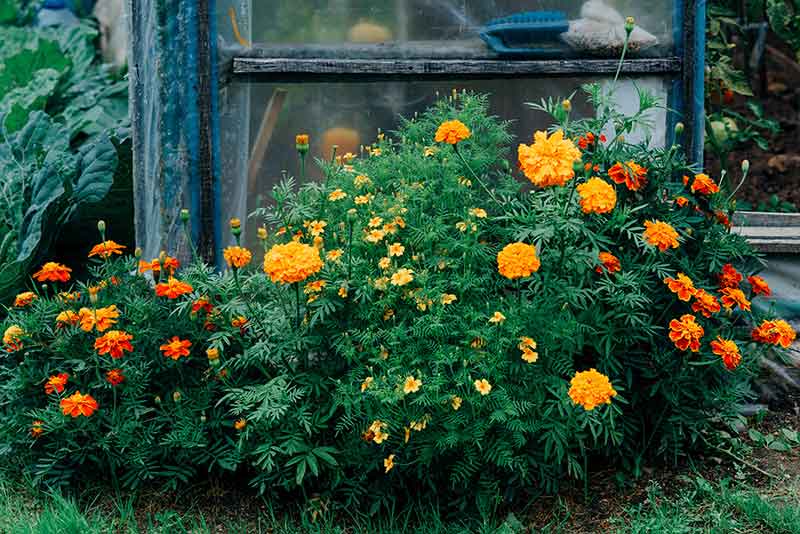
So you’ve started your spring garden indoors, and now you’re wondering about how to make the transition to outdoors when the weather warms up. Good news, we’ve got some expert spring planting tips for flower and vegetable gardens, or a combination of the two! Even if you didn’t get bulbs planted last fall or haven’t started your spring garden indoors yet, you can still have an awesome garden with some plants that are easy to grow, and some flowers that will help keep bugs away from your precious veggies.
Tip #1: Using planters, raised and elevated beds. Raised beds offer you the chance to get really creative and build boxes in different shapes. You can have squares, rectangles, triangles, even star shaped planter boxes. If you don’t want to put your plants in the ground, you can always opt for pots or planters. There are lots of advantages to a planter garden, including the freedom to arrange your plants (or rearrange them) any way you like. You can have flowers or veggies right on the back deck just outside your door when you use planter boxes. You can also place your planters on raised platforms to eliminate the need for getting on your knees or constantly bending over, which can be hard on your back. Think picnic tables, sawhorses, or building a frame yourself out of scrap lumber. All you need is a drill, a few pieces of wood, some screws, about an hour on a sunny day, and this easy raised platform tutorial from the Pioneer Woman.
Tip #2: Companion planting. Before you choose which plants you’ll have in your garden this year, arrange your planters in a few different configurations to see which you like best. It’s a lot easier to move these containers before they’re full of dirt and fragile baby plants! Read up on companion planting and you’ll see that pairing the right flowers and veggies with one another will keep the pests at bay. For example, marigolds are a great way to keep your tomatoes slug free, and a little basil planted near those bug free tomatoes will enhance their flavor.
Tip #3: Choose native plants. Plants which are already acclimated to your local climate will need less care and usually grow much better with less fuss than a non-native plant. Your local nursery expert can help you choose from a list of plants that are native to your region to get the best results.
Tip #4: Make it easy on yourself. When planting vegetables in your garden, choose easy growing, low maintenance plants like peas, green beans, carrots, radishes, and lettuce. Not only will you have the makings of a fresh salad at your fingertips, but these plants require only minimal maintenance for maximum yield.

Tip #5: Opt for functional flowers. Planting flowers in and around your vegetables is not only aesthetically pleasing, but smart! Along with the tomato-friendly marigold, other smart choices for your vegetable garden include borage, chrysanthemums, nasturtiums, petunias, and zinnias. Even better, growing edible flowers in your vegetable garden not only adds color and interest while keeping the pests away from your growing veggies, but gives you something beautiful to add to your summer salad plate. Note: People with severe allergies and children under the age of four should avoid eating flowers.
Here’s a list of edible flowers to consider adding to your garden. For plants like cilantro, dill, fennel, oregano, and rosemary, don’t toss the flowers when you’re gathering the leaves, as the flowers are also edible and make a great addition to most dishes:
- Agastache
- Borage
- Cilantro
- Dill
- Fennel
- Lemon balm
- Marigolds (gem type)
- Marjoram
- Oregano
- Pansies
- Roses
- Rosemary
- Sage
- Squash
- Thyme
Tip #6: Transition gradually. The process of transitioning your seedlings from an indoor garden to outdoors is known as “hardening off”. The first day, take your seedlings outdoors for a short time. An overcast day is perfect, but if it’s a sunny day you can set your trays in a shady location to prevent the baby plants from getting baked by the sun. Allow the seedlings to sit outside for two to three hours at a time to get used to being in the elements. For day two, expose the plants to sun for two to three hours again, then set them in the shade for two to three hours.
Gradually increase the number of hours your seedlings are exposed to the outdoors over the next five days, and place them back under their indoor grow lights each night. The key is to acclimate your seedlings gradually, giving them time to adjust to sunlight, wind, rain, and other elements. Once your young plants have been outside for a full 24 hours, it’s time to put them in the ground and watch them grow.

Tip #7: Plant in succession. Instead of being inundated all at once with plants that ripen at the same time, stagger your plantings so that you can enjoy a stead supply of fresh vegetables all season long, and relieve yourself of the pressure to get everything in the ground at the same time. You can plant something new every week throughout the growing season, and interplant crops that grow rapidly, like radishes, near other veggies that take a little longer, like carrots. This makes thinning the beds out easier when the time comes.
Tip #8: If you’re just planting flowers or planting a flower garden separate from your herbs and vegetables, variety in color, shape, texture, scent, and height is the key to creating a garden full of interest. Start with a small plot and choose the shape of your garden. Draw it out on paper to get an idea of the finished product. Consider bloom time and color combinations, and be sure to plant shorter flowers so that they don’t become obscured or blocked from receiving necessary sunlight by the shadow of a taller plant growing in front of them.
Tip #9: Choose a focal point for your floral bed, such as a sculpture, gazing ball, bird bath, fountain, or simply a cluster of taller plantings in the center to give the eye a starting point. For months of enjoyment, incorporate shrubs that bloom in spring, bulbs that bloom in fall, and summer perennials. Ornamental grasses are a good way to break up bright spots of color and provide some cooling shades of green amid a riot of summer color.

Tip #10: Mulch and water regularly until your garden is well established. Newly planted flowers need protection and time to become established. Keep an eye on the weather, and supplement any rainfall as needed, making sure your flowers get at least an inch of water every week. Whether you decide on flowers, vegetables, herbs, or a combination garden, we hope these tips will help you enjoy the fruits of your gardening labor. Remember to wear a comfy, wide-brimmed hat and apply sunscreen before you spend the day outdoors in your garden!





